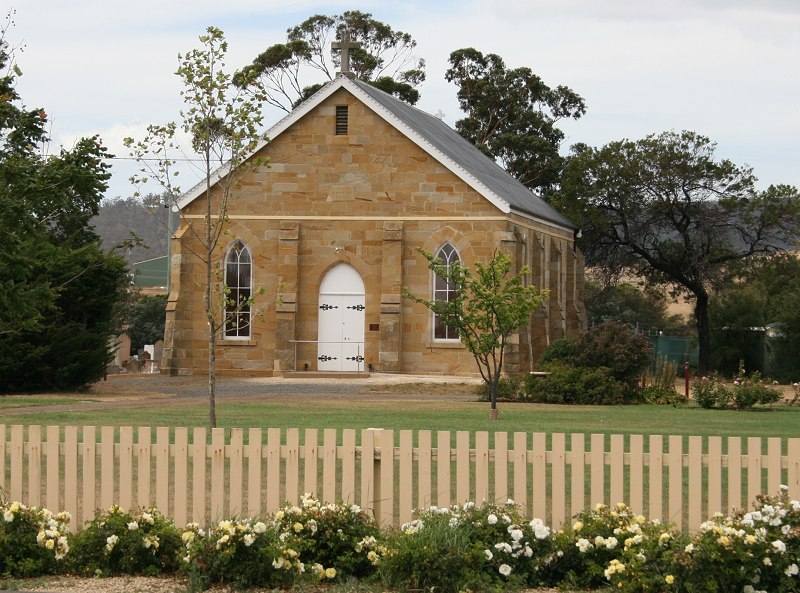The first church was built in the 1820s. Eventually it reached such a state of disrepair that it could no longer be used for services. It was pulled down and the materials used to build a new, smaller church that was consecrated in 1885.
Construction & consecration of first church
On Monday last, His Honor the LIEUTENANT GOVERNOR accompanied by the Chief Justice, Captain Cotton, Captain Montagu, Captain Lockyer, the Rev. Mr. Bedford, the Rev. Mr. Garrard, Mr. Lambe, Mr. Gordon, Mr. Butcher, and a large assemblage of Ladies and Gentlemen of the neighbourhood, laid the first stone of St. George’s Church, Sorell Town. After the ceremony, Mr. Garrard delivered an impressive discourse. It awakened emotions peculiarly sweet and touching, to see an assembly meet, for the first time, to hear the truths of the gospel on a spot which had been, since the creation, under the dominion of ignorance. We could not divest ourselves from the idea, that the offspring of the surrounding territory were to look for salvation from the truths about to be promulgated in the temple now erecting. Without improvement in religion, all other improvement is but vain and profit less. After the discourse His Honor visited the Public School, and was pleased to express himself satisfied, with the progress of the scholars.
Hobart Town Gazette, 13 August 1825
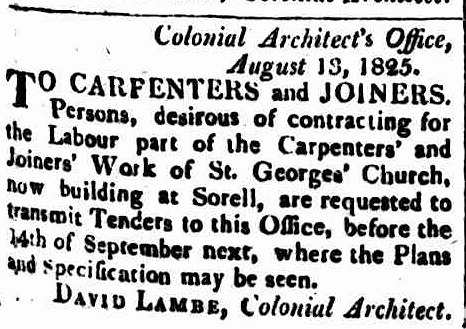
Hobart Town Gazette, 20 August 1825
We understand from our Correspondent at Sorell, that the Church newly erected is now nearly finished ; and that Divine Service will be performed there shortly, much to the satisfaction of the inhabitants.
Colonial Times, 15 September 1826
SORELL CHURCH.-We understand the Venerable the Archdeacon will consecrate the Sorell Town Church next week, and also examine the Public School there, which we are happy to learn has given much satisfaction of late.
Sydney Gazette, 16 April 1828
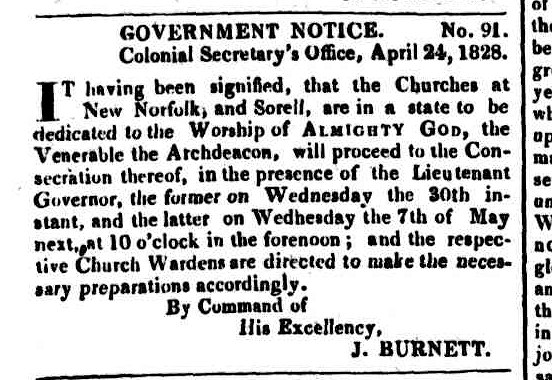
Hobart Town Courier, 26 April 1828
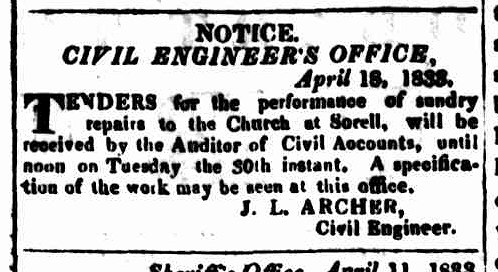
Hobart Town Courier, 19 April 1833
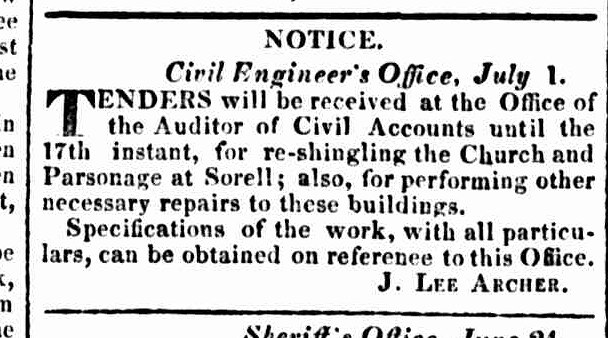
Hobart Town Courier, 3 July 1835
Consideration of what to do about deteriorating church
A meeting of the members and friends of the Episcopalian Church was held, pursuant to announcement, in the Council Chambers, Sorell, on Monday evening
From Bishop’s speech:
There was no reason why the people of Sorell should not have a church suited to their wants, in which they could meet for the worship of their Maker. There was no disguising the fact that ” the house of God at Sorell was now in ruins ;” and the question they had to consider was, what was the remedy ? Various suggestions had been made. One was, that the present building be repaired; and he believed an estimate of the cost had been obtained. By the adoption of this plan, the inclined walls might be braced into their perpendicular, and internal alterations effected ; but, at best this would be a piece of patch work, which would last but for a time. It had also been suggested that an arrangement might be made by which the Presbyterian Church might be rendered available for both the Presbyterians and Episcopalians. If, by such an arrangement, these two Christian bodies could be brought into closer union, and in the end, fused into one, he was not aware of any insuperable objection ;but experience had shown him that these co-partner ships, did not, as a general rule, work well. Their Presbyterian brethren had long since vacated their church at Sorell ; and in the colonies-where all churches were on the same equality-old differences of past times were so bridged over, that the Presbyterians of Sorell, had been quite content for some years past to cast in their lot and worship in the Episcopalian Church ; and he thought, in a place where the Presbyterians were not numerically, but as they were throughout the colony, influentially strong, it was a pity to disturb existing harmony, and a little better than a waste of energy to deride, where no real cause for division existed. All students of church history must know that the causes which in by-gone times separated the kirk from the episcopacy had no place in the colonies in these modern times. Another, and that which he considered the best plan had been proposed ; and that was to take down the present building, utilize the material, and erect a new and smaller church. If this could be done, as some imagined it could, at a moderate cost, he would strongly recommend it. The present building was too large, and the congregation were, as a consequence, too scattered. He believed in the sympathy of numbers. He considered the services of their church was deprived of their chief excellency when the hearty responses of the congregation were wanting ; and, amongst a scattered congregation, united and hearty responses could scarcely be looked for. Several churches had been recently built, so that additions might, in after time, as in the case of the Cathedral at Hobart Town, and the little church at Glenorchy-be made, when they became too small for the wants of the worshippers. If they could at present do no more, let them erect the nave, and the chancel when they required it. And this was the plan he would commend for their adoption.
The Mercury, 23 January 1874
ST. GEORGE’S CHURCH.
A meeting of the parishioners of St. George’s Church was held at the Council Chamber, Sorell, on Friday evening. Charles Hazell, Esq., J.P., occupied the chair; and the following business was transacted.
Moved by Mr. Clement Crocker, and seconded by Mr. Edwin Bilton:- That the patronage of the Care of St. George’s, Sorell, be vested in the following Board :Rev. C. J. Brammall, Dr. Parsons, and Messrs. C. Hazell, D. Ogilvy, G. W. Westbrook, W. Tarleton, W. Belbin, C. O. Abbot, and W. Lovett.
The desirability of repairing or re-erecting the church was considered, when several additions were made to the committee appointed on the 10th January. Mr. Hazell was appointed Treasurer, and the Rev. C. J. Brammall the Secretary, and it was resolved that subscription lists for carrying out the object be printed and circulated, and that Mr. H. L. Garrett be requested to act as Treasurer for Hobart Town.
The Rev. C. J. BRAMMALL detailed at some length his having, through the kindness of the Rev. J. Burrowes, received a lithograph of Bridgewater Church (produced) with plans and specifications, and that he had also visited the church at Prossers Plains, and the prevalent idea among the committee seemed to be that one, say 50 x 30, for the nave, would be ample.
Mr. HARRIS suggested that a bazaar be held during the winter months, as, without the ladies, nothing could he effectually carried out (a remark which elicited loud cries of “hear, hear.”) A tea meeting and concert he considered would materially supplement the funds.
A vote of thanks to the chairman being duly proposed and acknowledged, the meeting adjourned to 7 p.m. on Tuesday, 28th April.
The Mercury, 13 April 1874
CHURCH UNITY.
As I now write, and the church bells are ringing, I am reminded of a circumstance which, in our little community, is worthy of note, as showing the kindly feeling which I exists, between the ministers of the Church of England and the Church of Scotland at Sorell. The Scottish Church, though recently repaired, is dependent on the occasional visits of the Rev. J. Scott from Hobart Town,’ or visiting ministers from the other colonies, for the periodical supply of its pulpit. The Church of England is sadly out of order, and, although the little flock of the Rev. C J. Brammall are doing their best to repair the old church of St. George’s, or build a new one in its stead, the want of a more suitable place of worship has of late, on several occasions, been sadly felt ; and, with a truly Catholic spirit, the Scottish Church has been placed at the service of the Rev. C J. Brammall (the incumbent of St. George’s) by the Presbytery of Tasmania, at the instance of the Rev. J. Scott,. of St. John’s, Hobart Town. Were this kindly interchange of friendly offices the rule, instead of the exception, between the different Protestant Churches, bigotry would soon find no place amongst us, and the great distinguishing mark of true religion–as given by the Great Head of the Christian Church himself–would stand out in bold relief, “By this shall all men know that ye are my disciples, if ye love one’ another.”.
The Mercury, 23 February 1874
When the present contract is completed, and the Cambridge section improved, the drive to Sorell will be one of the most pleasant in the southern part of the island ; and students of natural history may have an opportunity of seeing a veritable mammal, spouting near, if not under, the central portion of the Sorell Causeway. The Church of England building, which is in so very dilapidated a condition that service cannot be held in it, will most probably be removed, and a smaller and more suitable edifice erected in its place. The inhabitants have also determined to have some public place for holding entertainments, etc., there being at present a considerable sum of money in hand for that purpose.
The Mercury, 25 July 1878
SORELL.
[From our own Correspondent.]
A numerously attended and influential meeting was held, pursuant to advertisement, in the Sorell Institute, on Monday, March 20, in order to consider the best means of restoring St. George’s Church. The Rev. C. J. Brammall presided, and after devotional exercises, explained that the meeting had been called in order to obtain the opinion of the parishioners as to whether it would be best to accept a tender for the repairs of the old church or to take steps to rebuild it, utilising, as far as practicable, the material in the old building, had been agreed at a meeting held on March 16 to adopt the former course, but by so narrow a majority that it bad been deemed advisable to obtain a wider expression of opinion on the subject. There was a difference of opinion in reference to the expenditure of the funds now in hand, and in order that all might have a voice in the disposal, the present meeting was called.
[continued]
The Mercury, 1882
It has been decided to rebuild St. George’s Church, Sorell, which has been in a state of dilapidation, and unused for purposes of Divine worship for some years. Steps are now being taken to raise the necessary funds.
The Mercury, 28 March 1882
Construction & consecration of second church
St. George’s Church, Sorell.
The committee for the re-building of St. George’s Church, Sorell, are about to have a sale of stock and produce in aid of the undertaking. The recent splendid rains with which the farmers have been favoured will, no doubt, induce them, to, contribute liberally in kind, to assist the fund. It is hoped that by the end of the year the committee may feel justified in taking steps to commence work.
The Mercury, 24 October 1882
St. George’s Church, Sorell.
To-day will be a gala day at the prettily situated township of Sorell, when the comer stone of the new Anglican church will be laid by Bishop Sandford. The ceremonies will commence this morning at half-past 11 o’clock, when the Holy Communion will be administered, and at 2 o’clock the stone will be well and truly laid, It is unnecessary to remind the good churchman of the district, as well as the many visitors expected from the capital and surrounding districts, that liberal offerings in aid of the St. George’s Church building fund are expected to be placed on the stone, in the evening, at 6 o’clock, a tea meeting in honour of the event will take place in the Sorell institute. A means to be present at the proceedings is provided for city folks by Tyler’s conveyances, winch will start from Bellerive on the arrival of the 8.30 steamer from town.
The Mercury, 23 October 1883
SORELL, Oct. 23. Bishop Sandford visited Sorell to-day, to lay the foundation-stone of the new Anglican church. At half-past two o’clock the clergy, amongst whom were Dean Bromby, Canon S. Mason, and the Revs. C. J. Brammall and Woolnough, arrived in processional order from the Rev. Sir. Brammall’s residence on the township, at the place where the new structure is being erected. After the ceremony of laying the foundation stone was finished, Bishop Sandford gave an eloquent and appropriate discourse in the presence of about 400 persons. The contract for the erection of the church is taken at £925, the contractors being allowed to use material taken from the old church building and they are erecting the new one within the place where the old structure stood. A tea-meeting will take place to-night in the Public Assembly Room, at which Bishop Sandford will be present.
Launceston Examiner, 24 October 1883
St George’s Church, Sorell, will be consecrated on the 11th inst, and a tea meeting will be hold in the evening.
The Mercury, 6 June 1884
ST. GEORGE’S CHURCH, SORELL.
The ceremony in connection with the formal consecration of this church was performed by Bishop Sandford on Wednesday morning, June 11. The want of proper accommodation for the Episcopalians of the district has been felt for a considerable time past. It is rarely in these colonies that any of the church buildings are found too large for ordinary purposes of worship, but for many years very considerable inconvenience had been felt by the residents of Sorell and the adjacent country, in consequence of the inordinate size of the edifice in which they were accustomed to meet for Divine service. Exertions were therefore made by the incumbent (Rev. C. J. Brammall), assisted by his congregation, to replace the old structure by a building more adapted to the wants of the locality, and the duty of preparing plans was entrusted to an architect. Dissatisfied at the high figure £1,600 which the architect estimated would be the cost of work, the congregation resolved to undertake it upon their own responsibility, and accordingly let it out to contract to Messrs. Grubb Bros., of Hobart. The contract price itself was £925, but owing to the necessity of flooring, extra foundations, and attending to one or two smaller matters, this amount has been exceeded by £105, thus making the total cost about £1,030. Towards the payment of the debt which this expenditure necessarily incurred, several amounts have been subscribed, including two sums, one for £100, and the other for £50. There still remains a debt of about £350, however, on the building, but this was slightly reduced at the offertory taken at the close of the consecration service. The church itself is a plain unassuming structure, standing at the corner of Gordon and Fitzroy-streets, on the exact spot upon which stood the old State building which was erected in 1826.
The area of the church property is about 4 acres 3 roods, and the dimensions of the new building are 38ft., by a depth of 64ft., and a height of about 18ft. The seating accommodation in the old church has been retained for its substitute, with the exception of two seats in the front, which have been reserved for the choir, and there will now be holding capacity for about 200 persons. At the back are the two vestries, but there is no ornamental porch in front. The foundation-stone was laid in August last, but the edifice was practically completed about two months ago ; and, although owing possibly to financial considerations, the designers have worked upon the principle that plainness unadorned is adorned the most, the church will afford a pleasing addition to the somewhat limited architectural beauties of the town.
The Mercury, 12 June 1884
Plans: Plan Side elevation Front elevation
Photo: Church and graveyard
